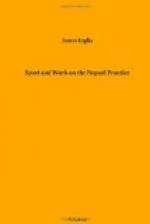Attached to every factory is a small settlement of labourers, belonging to a tribe of aborigines called Dangurs. These originally, I believe, came from Chota Nagpoor, which seems to have been their primal home. They are a cheerful industrious race, have a distinct language of their own, and only intermarry with each other. Long ago, when there were no post carriages to the hills, and but few roads, the Dangurs were largely employed as dale runners, or postmen. Some few of them settled with their families on lands near the foot of the hills in Purneah, and gradually others made their way northwards, until now there is scarcely a factory in Behar that has not its Dangur tola, or village.
The men are tractable, merry-hearted, and faithful. The women betray none of the exaggerated modesty which is characteristic of Hindoo women generally. They never turn aside and hide their faces as you pass, but look up to you with a merry smile on their countenances, and exchange greetings with the utmost frankness. In a future chapter I may speak at greater length of the Dangurs; at present it suffices to say, that they form a sort of appanage to the factory, and are in fact treated as part of the permanent staff.
Each Dangur when he marries, gets some grass and bamboos from the factory to build a house, and a small plot of ground to serve as a garden, for which he pays a very small rent, or in many instances nothing at all. In return, he is always on the spot ready for any factory work that may be going on, for which he has his daily wage. Some factories pay by the month, but the general custom is to charge for hoeing by piece-work, and during manufacture, when the work is constant, there is paid a monthly wage.
In the close foggy mornings of October and November, long before the sun is up, the Dangurs are hard at work in the Zeraats, turning up the soil with their kodalies, (a kind of cutting hoe,) and you can often hear their merry voices rising through the mist, as they crack jokes with each other to enliven their work, or troll one of their quaint native ditties.
They are presided over by a ‘mate,’ generally one of the oldest men and first settlers in the village. If he has had a large family, his sons look up to him, and his sons-in-law obey his orders with the utmost fealty. The ‘mate’ settles all disputes, presents all grievances to the sahib, and all orders are given through him.
The indigo stubble which has been left in the ground is perhaps about a foot high, and as they cut it out, their wives and children come to gather up the sticks for fuel, and this of course also helps to clean the land. By eleven o’clock, when the sluggish mist has been dissipated by the rays of the scorching sun, the day’s labour is nearly concluded. You will then see the swarthy Dangur, with his favourite child on his shoulder, wending his way back to his hut, followed by his comely wife carrying his hoe, and a tribe of little ones bringing up the rear, each carrying bundles of the indigo stubble which the industrious father has dug up during the early hours of morning.




